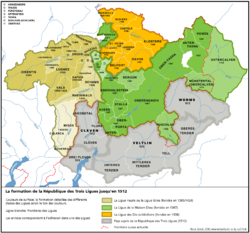League of Gods House
| League of God's House | ||||||||||||||||||||||||||
|
Gotteshausbund (de) Italian: Lega Caddea Romansh: Lia da la Chadé) |
||||||||||||||||||||||||||
| Associate of the Old Swiss Confederacy | ||||||||||||||||||||||||||
|
||||||||||||||||||||||||||
|
Coat of arms of the League of God's House
|
||||||||||||||||||||||||||
|
The League of God's House in green within the Three Leagues. The Grey League is shown in shades of brown, the League of the Ten Jurisdictions is shown in orange and subject territories, subsequently lost, in grey.
|
||||||||||||||||||||||||||
| Capital | Chur | |||||||||||||||||||||||||
| Government | Republic | |||||||||||||||||||||||||
| Historical era | Middle Ages | |||||||||||||||||||||||||
| • | League of God's House founded | 1367 | ||||||||||||||||||||||||
| • | Standing council formed | 1409 | ||||||||||||||||||||||||
| • | Closer ties to Three Leagues and de facto independence (HRE) |
late 15th century |
||||||||||||||||||||||||
| • |
Ilanzer Article removes Bishops political power |
1524 to 1526 |
||||||||||||||||||||||||
| • |
Bundesbrief constitution for the Three Leagues |
September 23, 1524 |
||||||||||||||||||||||||
| • | Annexed to the Helvetic Republic |
April 21, 1799 |
||||||||||||||||||||||||
|
||||||||||||||||||||||||||
The League of God's House (German: Gotteshausbund, Italian: Lega Caddea, Romansh: ![]() Lia da la Chadé ) was formed in what is now Switzerland on January 29, 1367 to resist the rising power of the Bishopric of Chur and the House of Habsburg. The League allied with the Grey League and the League of the Ten Jurisdictions in 1471 to form the Three Leagues. The League of God's House, together with the two other Leagues, was allied with the Old Swiss Confederacy throughout the 15th and 16th centuries. After the Napoleonic wars the League of God's House became a part of the Swiss canton of Graubünden.
Lia da la Chadé ) was formed in what is now Switzerland on January 29, 1367 to resist the rising power of the Bishopric of Chur and the House of Habsburg. The League allied with the Grey League and the League of the Ten Jurisdictions in 1471 to form the Three Leagues. The League of God's House, together with the two other Leagues, was allied with the Old Swiss Confederacy throughout the 15th and 16th centuries. After the Napoleonic wars the League of God's House became a part of the Swiss canton of Graubünden.
The region that would become the League of God's House has always been heavily influenced by the Diocese of Chur. The Bishop of Chur is first mentioned in 451 when its Bishop St. Asimo attended the Synod of Milan, but probably existed a century earlier. During the 5th and 6th centuries there is evidence of an extensive Romanisation and conversion to Christianity in the region around Chur. In 536 the region was conquered by the Merovingian Kingdom, but due to distance and isolation it quickly fell back into de facto independence. During this time the region was known as Churrätien or Churwalchen and occupied politically virtually the same territory that the Bishopric of Chur spiritually led. In 773 the political and spiritual power in the region was consolidated into a single family. However this situation only lasted until 806 when Charlemagne split the political and spiritual power into two. This split and the resulting conflicts let to the collapse of Churrätien and the creation of numerous small independent communities, with the power center of Chur in the middle. For centuries after the split, the Bishops of Chur wished to expand their power both politically and spiritually.
...
Wikipedia


